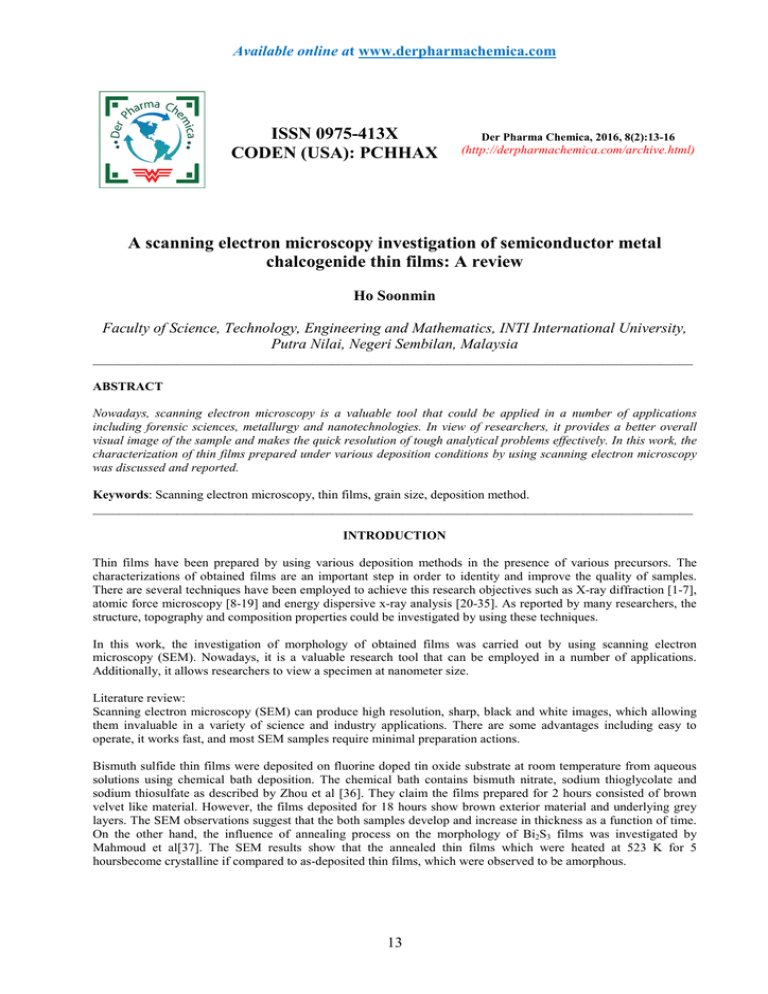A scanning electron microscopy investigation of semiconductor
advertisement

Available online at www.derpharmachemica.com ISSN 0975-413X CODEN (USA): PCHHAX Der Pharma Chemica, 2016, 8(2):13-16 (http://derpharmachemica.com/archive.html) A scanning electron microscopy investigation of semiconductor metal chalcogenide thin films: A review Ho Soonmin Faculty of Science, Technology, Engineering and Mathematics, INTI International University, Putra Nilai, Negeri Sembilan, Malaysia _____________________________________________________________________________________________ ABSTRACT Nowadays, scanning electron microscopy is a valuable tool that could be applied in a number of applications including forensic sciences, metallurgy and nanotechnologies. In view of researchers, it provides a better overall visual image of the sample and makes the quick resolution of tough analytical problems effectively. In this work, the characterization of thin films prepared under various deposition conditions by using scanning electron microscopy was discussed and reported. Keywords: Scanning electron microscopy, thin films, grain size, deposition method. _____________________________________________________________________________________________ INTRODUCTION Thin films have been prepared by using various deposition methods in the presence of various precursors. The characterizations of obtained films are an important step in order to identity and improve the quality of samples. There are several techniques have been employed to achieve this research objectives such as X-ray diffraction [1-7], atomic force microscopy [8-19] and energy dispersive x-ray analysis [20-35]. As reported by many researchers, the structure, topography and composition properties could be investigated by using these techniques. In this work, the investigation of morphology of obtained films was carried out by using scanning electron microscopy (SEM). Nowadays, it is a valuable research tool that can be employed in a number of applications. Additionally, it allows researchers to view a specimen at nanometer size. Literature review: Scanning electron microscopy (SEM) can produce high resolution, sharp, black and white images, which allowing them invaluable in a variety of science and industry applications. There are some advantages including easy to operate, it works fast, and most SEM samples require minimal preparation actions. Bismuth sulfide thin films were deposited on fluorine doped tin oxide substrate at room temperature from aqueous solutions using chemical bath deposition. The chemical bath contains bismuth nitrate, sodium thioglycolate and sodium thiosulfate as described by Zhou et al [36]. They claim the films prepared for 2 hours consisted of brown velvet like material. However, the films deposited for 18 hours show brown exterior material and underlying grey layers. The SEM observations suggest that the both samples develop and increase in thickness as a function of time. On the other hand, the influence of annealing process on the morphology of Bi2S3 films was investigated by Mahmoud et al[37]. The SEM results show that the annealed thin films which were heated at 523 K for 5 hoursbecome crystalline if compared to as-deposited thin films, which were observed to be amorphous. 13 Ho Soonmin Der Pharma Chemica, 2016, 8 (2):13-16 _____________________________________________________________________________ Cu2S films were prepared by Pathan et al [38] using chemical bath deposition method in the presence of copper sulphate and sodium sulphide. The deposition was carried out at bath temperature of 27 °C at the pH of 12. They can observe that the films are dense, smooth and homogeneous without visible pores. Isac et al [39] have reported the synthesis of Cu2S films using spray pyrolysis deposition method. The influence of the precursor solution concentration on the morphology of films was studied by them. The SEM results indicate that a higher growth rate could be observed at higher copper concentration. As a result, average grain size increases from 330 nm to 500 nm, as the copper concentration was increased from 0.2 to 0.25 M. Zinc sulfide thin films were deposited on glass substrate from an aqueous solution as proposed by Gunasekaran et al [40]. The influence of the annealing temperature on the morphology of films was described by them. It is evidenced from the SEM results that the surface morphology of the films was improved by annealing at various temperatures from 100 to 500 °C. On the other hand, Poulomi et al [41] have reported that the different sized grain particles were distributed randomly throughout the substrate without any crack. These films were prepared using chemical bath deposition method and were heated at 500 °C. Additionally, they conclude that the particle size ranges from few nanometers to 100 nm and they are agglomerated in some places. In the other case, chemical bath deposited ZnS films in zinc acetate (Zn2+)-thioacetamide (TAA) aqueous solutions has been investigated by Koichi et al [42]. The SEM micrographs show that the morphologies are very different for the films prepared under two extreme conditions such as [Zn2+]/[TAA]=0.4M/0.1M and 0.1M/0.4M. It can be seen that there are much smaller particles with diameters of around 0.5 µm were produced with excess TAA. The morphology of the electrodeposited FeS2 films has been studied by Dong et al [43] using SEM technique. The films were deposited onto indium tin oxide glass in the bath containing FeCl2 and Na2S2O3 solutions. The grain size about 130 nm could be determined using SEM for the films annealed at 500 °C. Iron selenide (FeSe) films were prepared using electro deposition method by Pawar et al [44]. The stainless steel was used a substrate during the deposition in the presence of FeCl3, SeO2 and triethylamine (TEA) solutions. The surface morphology studies reveal that these films are uniform and pinhole free with spherical shaped grains covering the substrate. Surface morphology of the chemical bath deposited CuInS2 films was observed to be very sensitive to the Cu/In ratio as described by Mahanubhav et al [45]. The increase in grain size from 31.6 nm to 61.3 nm could be found with increase in Cu/In ratio as shown in SEM micrographs. Heini et al [46] have proposed that the preparation of PbTe films on substrate from alkaline medium. During the deposition, the disodium salt of ethylenediaminetetraacetic acid (Na2EDTA) was used to complex Pb2+ in order to prevent spontaneous precipitation of Pb(OH)2. The obtained films were uniform, metallic and silver gray. The SEM micrograph indicates that dense microstructure. Esparza-Ponce et al [47] have synthesized CdSe thin films using simple chemical bath deposition method. The chemicals used in the bath were cadmium chloride complexed with sodium citrate and sodium selenosulphate. The SEM investigation indicates the films were covered by spherical grain from few nanometers up to clusters of 0.5 µm. They also observe that the number of clusters increase as the deposition time increases from 2 to 6 hours. PbS films were deposited on SnO2:F coated glass using electro deposition method by Anup and Nillohit[48]. The deposition was carried out at the pH of 3 and at 80 °C for 120 minutes. The SEM micrographs reveal that a randomly oriented and a highly compact surface morphology. Also, the grain size is likely to be in the sub-micro range. Roy and Srivastava[49] have reported the deposition of CdS films using chemical bath deposition method in the presence of tartaric acid as complexing agent. SEM is very helpful to investigate the surface morphology of films as mentioned by them. The films annealed at 400 °C show that the smaller grains have sizes in nanometer range, meanwhile larger grains have sizes less than 1000 nm as observed in SEM micrographs. In other case, Barman et al [50] have revealed that the influence of pH on the morphology of films using SEM technique. They conclude that a slight increase of the grain size follows the pH decreasing from 2.2 to 1.6 but does not improve the surface roughness. They also point out that the semispherical grains are uniformly distributed at the surface of substrate. However, there are some disadvantages could be revealed such as the size and the cost. This equipment is considered as expensive and large. Furthermore, it must be housed in an area free of any electric and magnetic fields. Another problem is maintenance involves keeping a steady voltage, current to electromagnetic coils and circulation of cool water. Lastly, special training is required for technician to operate it as well as prepare samples. 14 Ho Soonmin Der Pharma Chemica, 2016, 8 (2):13-16 _____________________________________________________________________________ CONCLUSION The morphology of thin films prepared at various deposition conditions could be investigated using scanning electron microscopy as reported and discussed by many researchers. The scanning electron microscopy micrograph analysis must be carried out in order to determine the grain size distribution, average particle size and film homogeneity. Acknowledgement Inti International University is gratefully acknowledged for the financial support of this work. REFERENCES [1] D. Patidar, K.S. Rathore, N.S. Saxena, K. Sharma, T.P. Sharma, Chalcogenide Lett., 2008, 5, 21-25. [2] K. Anuar, W.T. Tan, H.A. Abdul, N. Saravanan, S.M. Ho, Macedonian J. Chem. Chem. Eng., 2010, 29, 97-103. [3] S.H. Kang, Y. Kim, D. Choi, Y. Sung, Electrochim. Acta, 2006, 51, 4433-4438. [4] K. Anuar, S.M. Ho, M. Shanthi, N. Saravanan, MakaraSains, 2010, 14, 117-120. [5] R. Poulomi, K.S. Suneel, J. Phys. D: Appl. Phys., 2006, 39, 4771-4776. [6] K. Anuar, S.M. Ho, S. Atan, N. Saravanan, Stud. U. Babes-Bolyai Chem., 2010, 55, 5-11. [7] Y. Rodriguez-Lazcano, M.T.S. Nair, P.K. Nair, J. Cryst. Growth, 2001, 223, 399-406. [8] K. Anuar, S.M. Ho, K.S. Lim, N. Saravanan, Int. Res. J. Chem., 2013, 3, 62-68. [9] K. Anuar, S.M. Ho, W.T. Tan, S.M. Ho, N. Saravanan, Asian J. Res. Chem., 2012, 5, 291-294. [10] K. Anuar, S.M. Ho., K.S. Lim, N. Saravanan, SQU J. Sci., 2011, 16, 24-33. [11] H.M. Pathan, C.D. Lokhande, Appl. Surf. Sci., 2005, 245, 328-334. [12] K. Anuar, S.M. Ho, W.T. Tee, K.S. Lim, N. Saravanan, Res. J. Appl. Sci. Eng. Technol., 2011, 3, 513-518. [13] A. Cortes, H. Gomez, R.E. Marotti, G. Riveros, E.A. Dalchiele, Sol. Energy Mater. Sol. Cells, 2004, 82, 21-34. [14] K. Anuar, S.M. Ho, Kelvin, W.T. Tan, N. Saravanan, Eur. J. Sci. Res., 2011, 66, 592-599. [15] S.M. Rabchynski, D.K. Ivanou, E.A. Streltsov, Electrochem. Commun.,2004, 6, 1051-1056. [16] S.M. Ho, Eur. J. Sci. Res., 2014, 125, 475-480. [17] K. Anuar, N. Saravanan, K. Zulkefly, S. Atan, W.T. Tan, S.M. Ho, Bull. Chem. Soc. Ethiop., 2010, 24, 259-266. [18] K. Anuar, S.M. Ho, W.T. Tan, S. Atan, K. Zulkefly, H. Jelas, N. Saravanan, CMU. J. Nat. Sci., 2008, 7, 317326. [19] K. Anuar, S.M. Ho, S. Atan, H. Jelas, N. Saravanan, Oriental J. Chem., 2011, 27, 1375-1381. [20] A.V. Kokate, M.R. Asabe, S.D. Delekar, L.V. Gavali, I.S. Mulla, P.P. Hankare, B.K. Chougule, J. Phys. Chem. Solids, 2006, 67, 2331-2336. [21] R.B. Kale, C.D. Lokhande, Semicond. Sci. Technol., 2005, 20, 1-9. [22] S.M. Pawar, A.V. Moholkar, C.H. Bhosale, Mater. Lett.,2007, 61, 1034-1038. [23] M. Soliman, A.B. Kashyout, M. Shabana, M. Elgamal, Renewable Energy, 2001, 23, 471-481. [24] H.L. Pushpalatha, S. Bellappa, T.N. Narayanaswamy, R. Ganesha, Indian J. Pure Appl. Phys., 2014, 52, 545549. [25] K. Anuar, S.M. Ho, W.T. Tan, R. Yazid, Ozean J. Appl. Sci., 2011, 4, 363-372. [26] S.S. Mali, P.S. Shinde, C.A. Betty, P.N. Bhosale, Y.W. Oh, P.S. Patil, J. Phys. Chem. Solids, 2012, 73, 735-740. [27] E.P. Subramaniam, G. Rajesh, N. Muthukumarasamy, M. Thambidurai, V. Asokan, D. Velauthapillai, Indian J. Pure Appl. Phys., 2014, 52, 620-624. [28] S. Seghaier, N. Kamoun, R. Brini, A.B. Amara, Mater. Chem. Phys., 2006, 97, 71-80. [29] V. Balasubramanian, N. Suriyanarayanan, R. Kannan, Arch. Appl. Sci. Res., 2012, 4, 1864-1868. [30] C. Gumus, C. Ulutas, R. Esen, O.M. Ozkendir, Y. Ufuktepe, Thin Solid Films, 2005, 492, 1-5. [31] S.M. Pawar, A.V. Moholkar, U.B. Suryavanshi, K.Y. Rajpure, C.H. Bhosale, Sol. Energy Mater. Sol. Cells, 2007, 560-565. [32] R. Chandramohan, T. Mahalingam, J.P. Chu, P.J. Sebastian, Sol. Energy Mater. Sol. Cells, 2004, 81, 371-378. [33] K. Li, X. Meng, X. Liang, H. Wang, H. Yan, J. Solid State Electrochem., 2006, 10, 48-53. [34] T. Mahalingam, A. Kathalingam, S. Velumani, S. Lee, K.S. Lew, Y.D. Kim, Semicond. Sci. Technol., 2005, 20, 749-754. [35] K. Anuar, S.M. Ho, K.S. Lim, N. Saravanan, Chalcogenide Lett., 2011, 8, 405-410. [36] L. Zhou, K. Govender, D.S. Boyle, P.J. Dale, L.M. Peter, P. O’Brien, J. Mater. Chem., 2006, 16, 3174-3176. [37] S. Mahmoud, A.H. Eid, H. Omar, Fizika A., 1997, 6, 111-120. [38] H.M. Pathan, J.D. Desai, C.D. Lokhande, Appl. Surf. Sci., 2002, 202, 47-56. [39] L. Isac, A. Dute, A. Kriza, S. Manolache, M. Nanu, Thin Solid Films, 2007, 515, 5755-5758. [40] M. Gunasekaran, R. Gopalakrishnan, P. Ramasamy, Mater. Lett.,2003, 58, 67-70. [41] R. Poulomi, R.O.Jyoti,K.S. Suneel, Thin Solid Films, 2006, 515, 1912-1917. [42] Y. Koichi, Y. Tsukasa, L. Daniel, M. Hideki, J. Phys. Chem. B., 2003, 107, 387-397. 15 Ho Soonmin Der Pharma Chemica, 2016, 8 (2):13-16 _____________________________________________________________________________ [43] Y.Z. Dong, Y.F. Zheng, H.Duan, Y.F. Sun, Y.H. Chen, Mater. Lett.,2005, 59, 2398-2402. [44] S.M. Pawar, A.V. Moholkar, U.B.Suryavanshi, K.Y. Rajpure, C.H. Bhosale, Sol. Energy Mater. Sol. Cells, 2007, 91, 560-565. [45] M.D. Mahanubhav, L.A. Patil, P.S. Sonawane, R.H. Bari, V.R., Patil, Sens. Transducers J., 2006, 73, 826-833. [46] S. Heini, K. Tapio, R. Mikko, L. Markku, Thin Solid Films, 1998, 326, 78-82. [47] H.E. Esparza-Ponce, J. Hernandez-Borja, A. Reves-Rojas, M. Cervantes-Sanchez, Y.V. Vorobiev, R. RamirezBon, J.F. Perez-Robles, J. Gonzalez-Hernandez, Mater. Chem. Phys., 2009, 113, 824-828. [48] M. Anup, M. Nillohit, Mater. Lett.,2006, 60, 2672-2674. [49] P. Roy, S.K. Srivastava, Mater. Chem. Phys., 2006, 95, 235-341. [50] J. Barman, J.P. Borah, K.C. Sarma, Chalcogenide Lett., 2008, 5, 265-271. 16




